thunderheart
100 W
Hi guys!
I've tested 2 old but still good 18650 batteries from LG - HB4 and HB6. They are both rated at 1500mAh and 30A continuous. 1500mAh seems to be ridiculous nowadays but if you buy them at a good price they can be a good choice for using in many high-drain applications (like power tools, for example).
My Li-ion battery supplier is Queen Battery, as always, and the tests were done using ZKETECH EBC-A20, which supports up to 20A discharge, 4-wire measurement and is PC-connected.

I'm still using the v2.5 of my battery holder which is going to be upgraded to v3.0 soon.
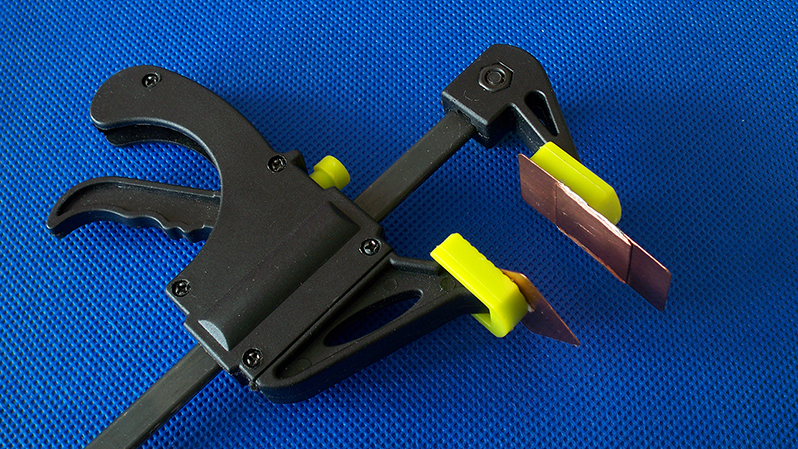
I've followed all the prescriptions of the IEC61960-2003 standard concerning battery's capacity measurement. Before each discharging cycle each battery was charged at standard current mentioned in its datasheet to charge end voltage (4.2V) (cut-off at 0.1A, which is the lowest supported by EBC-A20). Before each discharging or charging i've held a 1-1.5hrs pause. The environment temperature was about 25°C. To be sure in results i've done each test minimum twice.
LG ICR18650 HB4
This guy has the following marking: LGDAHB41865 Q193G124AC.
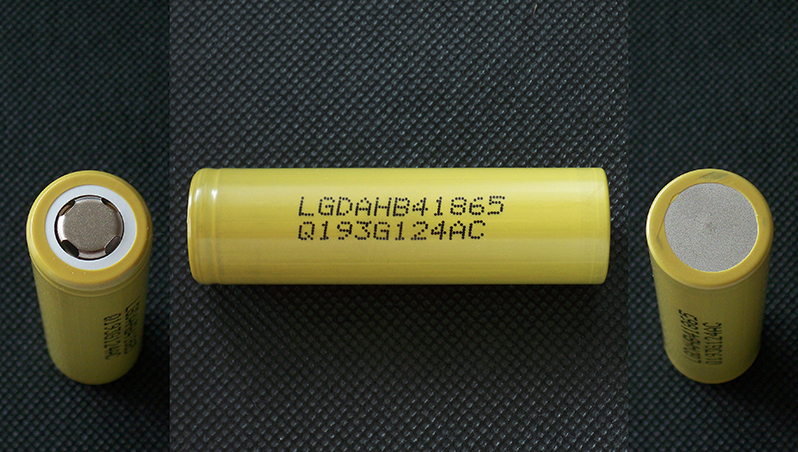
The main specs from its datasheet:
Minimum capacity: 1500mAh
Nominal voltage: 3.65V
Standard charge current: 0.75A
Maximum charge current: 4A
Charge end voltage: 4.2V
Charge cut-off current: 50mA (std chg) / 100mA (fast chg)
Standard discharge current: 0.3A
Maximum discharge current: 30A
Discharge cut-off voltage: 2.5V
Maximum weight: 46.1g
My sample's measured weight is 43.27g

Test results:
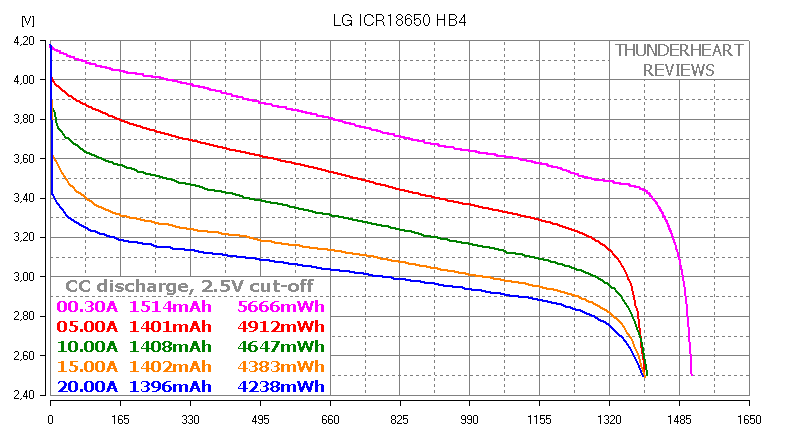
Good results. At 0.2C the capacity is slightly higher than declared and at higher discharge rates it plays around 1400mAh. Nice curves without ups and downs.
LG 18650 HB6
The HB6 cell i've got is marked LGDAHB61865 Q091D014A1
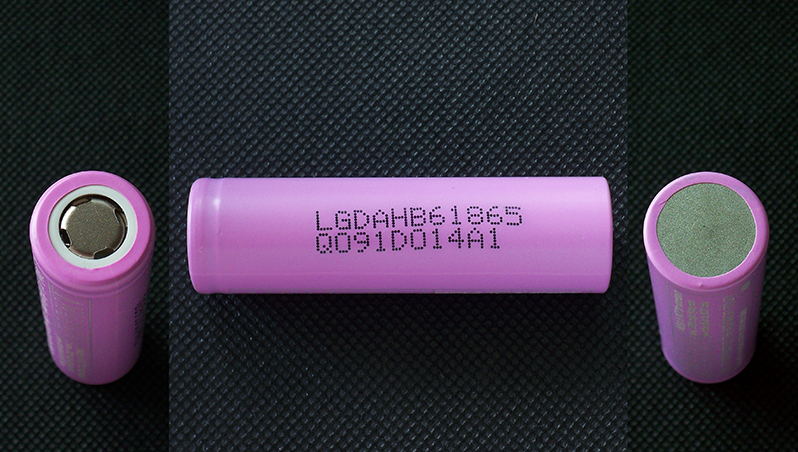
The main specs from its datasheet:
Nominal capacity: 1500mAh
Minimum capacity: 1400mAh
Nominal voltage: 3.65V
Standard charge current: 0.75A
Maximum charge current: 4A
Charge end voltage: 4.2V
Charge cut-off current: 50mA (std chg) / 100mA (fast chg)
Standard discharge current: 0.3A
Maximum discharge current: 30A
Discharge cut-off voltage: 2.0V
Maximum weight: 48g
My sample's measured weight is 43.13g
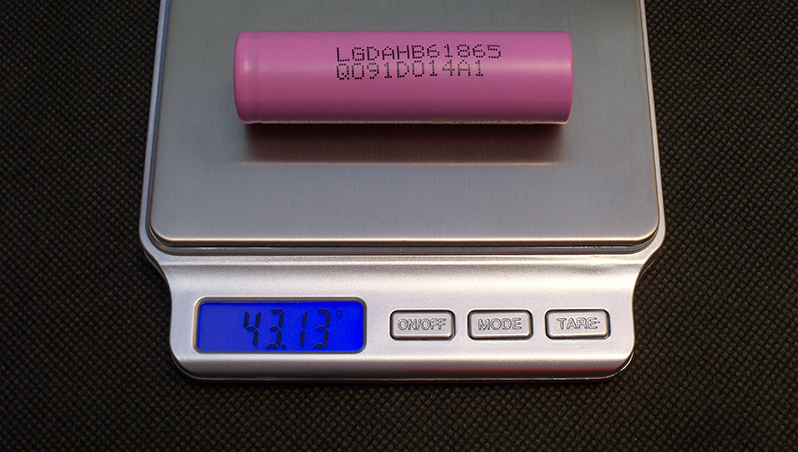
Test results:

Pay attention to the discharge cut-off voltage - it's 2.0V here. At 0.2C HB6's capacity is much more than declared - 1603mAh. There is one interesting moment here - all the way from 5A to 20A the capacity rises but the energy, of course, not. I'd prefer all the batteries to be marked using energy values, not capacity, but we've got what we've got.
1.5Ah and 4.6Wh at 20A discharge looks pretty good, better than 1.4Ah / 4.2Wh of HB4. So let's compare them.
COMPARISON
I'm not going to compare at 0.2C / 0.3A because 0.2C discharge test i'm doing for checking the nominal capacity only (the standard requires that). So let's start with 5A discharge test:

The curves are quite close. HB6 is ahead with its 1455mAh/5093mWh but even being discharged down to 2.5V it would still be ahead giving out 1435mAh vs HB4's 1401mAh.
10A discharge:

Here we can see the same picture but with bigger difference. HB6 does a good job!
15A discharge:

HB6's curve looks better in the beginning and looks more linear compared to HB4's curve. The difference keeps on rising.
20A discharge:
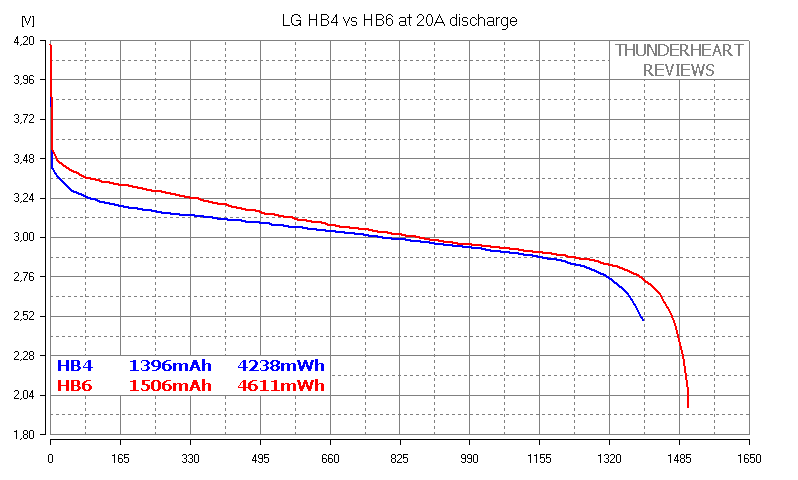
No doubt HB6 is the winner. Just look at the curves and the numbers.
CONCLUSION
Yes, HB6 is the clear winner and it has 3 advantages over HB4 which has the same rating:
1. HB6 can be discharged down to 2.0V even at 30A, while HB4 is limited by 2.5V
2. Even at 2.5V discharge cut-off HB6 is better than HB4
3. HB6's curves look more linear with less voltage sag compared to HB4.
The only advantage of HB4 is the slightly lower price - US$2.05 vs $2.25 (shipping not included).
I hope this test was interesting to read/watch and i'll be happy if it was useful for someone Here is the video version of this review
Here is the video version of this review

P.S. Your likes, comments and subscriptions are highly appreciated!
I've tested 2 old but still good 18650 batteries from LG - HB4 and HB6. They are both rated at 1500mAh and 30A continuous. 1500mAh seems to be ridiculous nowadays but if you buy them at a good price they can be a good choice for using in many high-drain applications (like power tools, for example).
My Li-ion battery supplier is Queen Battery, as always, and the tests were done using ZKETECH EBC-A20, which supports up to 20A discharge, 4-wire measurement and is PC-connected.

I'm still using the v2.5 of my battery holder which is going to be upgraded to v3.0 soon.

I've followed all the prescriptions of the IEC61960-2003 standard concerning battery's capacity measurement. Before each discharging cycle each battery was charged at standard current mentioned in its datasheet to charge end voltage (4.2V) (cut-off at 0.1A, which is the lowest supported by EBC-A20). Before each discharging or charging i've held a 1-1.5hrs pause. The environment temperature was about 25°C. To be sure in results i've done each test minimum twice.
LG ICR18650 HB4
This guy has the following marking: LGDAHB41865 Q193G124AC.

The main specs from its datasheet:
Minimum capacity: 1500mAh
Nominal voltage: 3.65V
Standard charge current: 0.75A
Maximum charge current: 4A
Charge end voltage: 4.2V
Charge cut-off current: 50mA (std chg) / 100mA (fast chg)
Standard discharge current: 0.3A
Maximum discharge current: 30A
Discharge cut-off voltage: 2.5V
Maximum weight: 46.1g
My sample's measured weight is 43.27g

Test results:

Good results. At 0.2C the capacity is slightly higher than declared and at higher discharge rates it plays around 1400mAh. Nice curves without ups and downs.
LG 18650 HB6
The HB6 cell i've got is marked LGDAHB61865 Q091D014A1

The main specs from its datasheet:
Nominal capacity: 1500mAh
Minimum capacity: 1400mAh
Nominal voltage: 3.65V
Standard charge current: 0.75A
Maximum charge current: 4A
Charge end voltage: 4.2V
Charge cut-off current: 50mA (std chg) / 100mA (fast chg)
Standard discharge current: 0.3A
Maximum discharge current: 30A
Discharge cut-off voltage: 2.0V
Maximum weight: 48g
My sample's measured weight is 43.13g

Test results:

Pay attention to the discharge cut-off voltage - it's 2.0V here. At 0.2C HB6's capacity is much more than declared - 1603mAh. There is one interesting moment here - all the way from 5A to 20A the capacity rises but the energy, of course, not. I'd prefer all the batteries to be marked using energy values, not capacity, but we've got what we've got.
1.5Ah and 4.6Wh at 20A discharge looks pretty good, better than 1.4Ah / 4.2Wh of HB4. So let's compare them.
COMPARISON
I'm not going to compare at 0.2C / 0.3A because 0.2C discharge test i'm doing for checking the nominal capacity only (the standard requires that). So let's start with 5A discharge test:

The curves are quite close. HB6 is ahead with its 1455mAh/5093mWh but even being discharged down to 2.5V it would still be ahead giving out 1435mAh vs HB4's 1401mAh.
10A discharge:

Here we can see the same picture but with bigger difference. HB6 does a good job!
15A discharge:

HB6's curve looks better in the beginning and looks more linear compared to HB4's curve. The difference keeps on rising.
20A discharge:

No doubt HB6 is the winner. Just look at the curves and the numbers.
CONCLUSION
Yes, HB6 is the clear winner and it has 3 advantages over HB4 which has the same rating:
1. HB6 can be discharged down to 2.0V even at 30A, while HB4 is limited by 2.5V
2. Even at 2.5V discharge cut-off HB6 is better than HB4
3. HB6's curves look more linear with less voltage sag compared to HB4.
The only advantage of HB4 is the slightly lower price - US$2.05 vs $2.25 (shipping not included).
I hope this test was interesting to read/watch and i'll be happy if it was useful for someone

P.S. Your likes, comments and subscriptions are highly appreciated!

